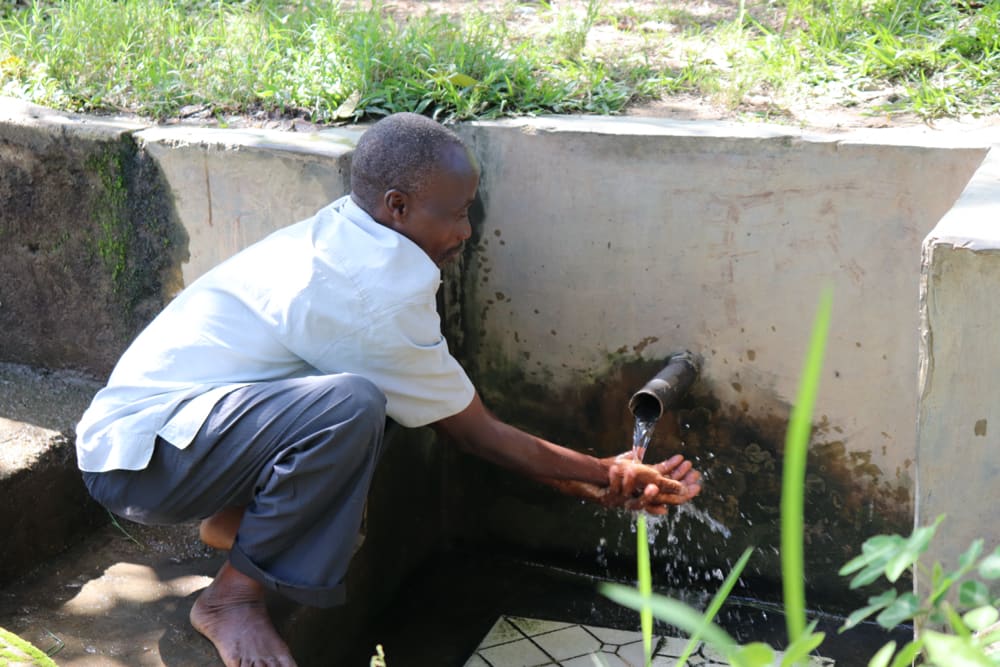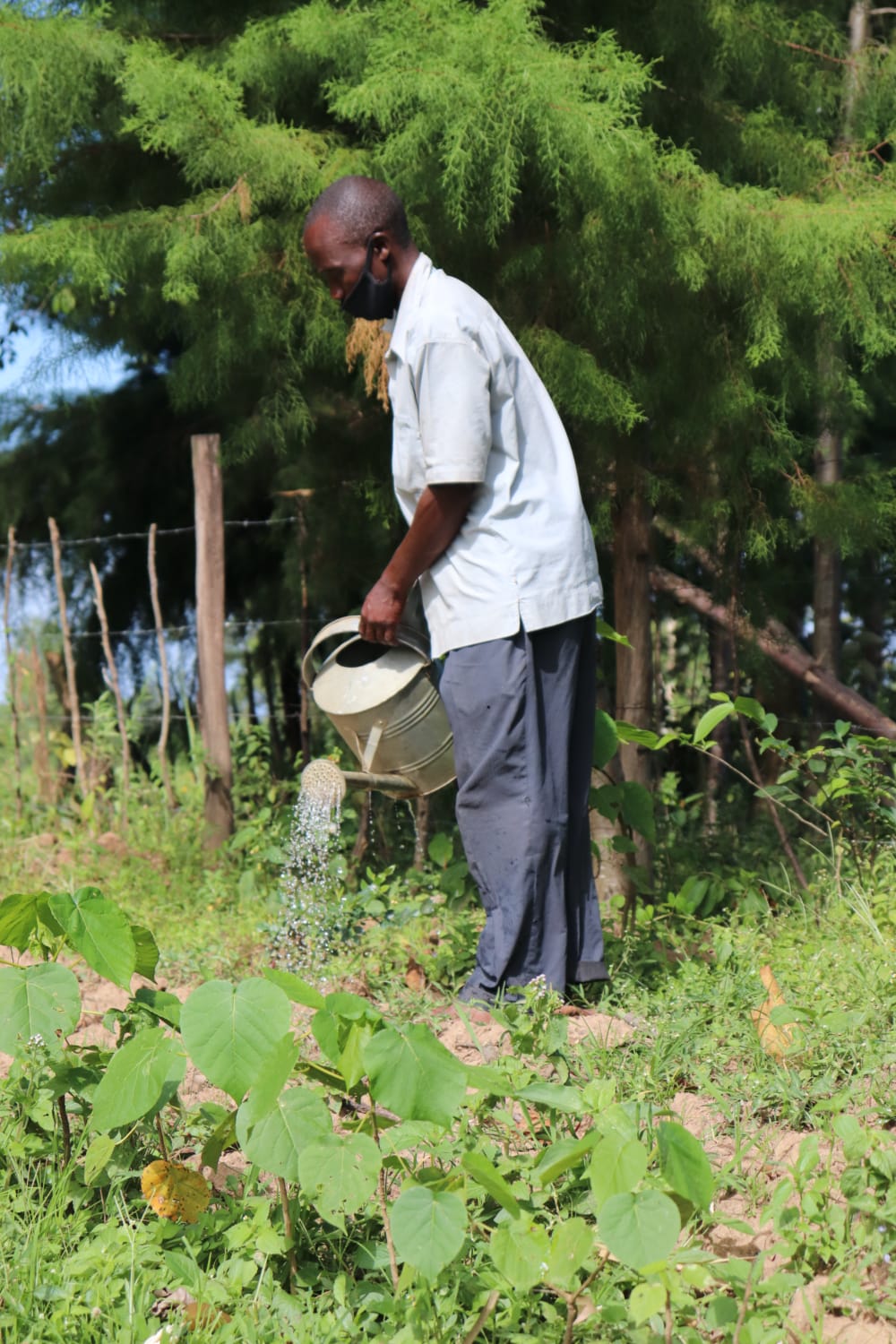This project is being implemented by our partner Western Water And Sanitation Forum and includes the construction of a spring protection system and latrine sanitation platforms (sanplats).
Background Information
This unprotected spring is located in Tsivaka village, Shieywe sub-location, Shirugu location, Kakamega North District within Kakamega County. The spring serves over 65 households with a total population of 475 people out of which 220 are men and 255 are women.
The water is used for drinking, cooking, watering animals and irrigation on the farms especially now due to the dry period.
Justification
The community members reported that they have suffered from many cases of waterborne diseases like diarrhea, typhoid, amoeba, and dysentery as a result of drinking water from this unprotected water spring. Since the spring is unprotected, it is open to contamination by surface runoff, people stepping into the water as they fetch and animals that also drink from it.
A lot of time is also wasted by the women who have to wait for the water to settle before fetching and as they wait they engage in gossips resulting in conflicts amongst themselves. With regard to water improvement, the community members stated they have been drinking that water for years and very few boil or disinfect it.
Sanitation is also a big problem as many people have no good latrines and others even use bushes. During the rainy seasons, the waste is washed into the spring leading to contamination of water.
The community members are in dire need of support and are urging WEWASAFO to consider them protect the spring so that they can reduce cases of waterborne diseases and also save time wasted to engage in other economic activities.
Progress Report:
The mobilization process of the community
The process of sensitization and mobilization was similar to that of Luseka spring and organization activities targeted both the local leaders and the community members. This begun by sensitization of Kakamega county Commissioner, Assistant county commissioner of Malava and the County Minister of Environment, water and natural resources. They were briefed on the project intervention in their areas.
This was followed up by sensitization of the local administration in the location, sub location and village level. This was aimed at creating awareness on the projects intervention in the area and also selection of the key resource persons to be trained as PRAs.
The PRA process
The PRA (participatory rural assessment) process was conducted with an objective of equipping participants with relevant skills of appraising the projects in the community and training on good leadership, management, monitoring and evaluation.
Representation was drawn from opinion leaders, community members, and village administrators.
Mapping of the community resources was done to assist the community members identify the locally available resources within their community and contribute the same towards the project. This ensures ownership and sustainability of the project. The community calendar was also done in order to identify key events in the community like market days, holidays, public meeting days and markets days. This assisted in planning for trainings and other project activities.
The implementation of the hardware for the project (spring protection, Sanitation platforms)
The protection of the spring has already started. Digging of the drainage started on the 3rd week of March and when complete, it will serve over 65 households with a total population of 475 people out of which 220 are Men and 255 are women.
When it comes to sanitation, five community members around the spring have been identified, the pits sunk and Sanitation platforms have already been casted and are undergoing the curing period. The selection criteria was based on the most needy members of the community. Therefore five vulnerable members of the community that lack toilets will receive these sanitation platforms.This was done In order to prevent contamination of the water sources by faeces resulting from open defecation.
The implementation of the WASH trainings
The Water and Sanitation management committee training was conducted on 23rd and 24th March, 2015 to the committee members for Tsivaka spring. They were equipped with relevant skills on management and maintenance of their water spring, good governance, funds collection and record keeping.
A total number of 24 people were trained out of which 8 were males and 16 were females.
Training sessions begun by a word of prayer from one of the participants. The Training officer welcomed all members and appreciated them for setting aside all their daily activities to attend the training. She then welcomed Mr.Shem Wanyama the owner of the home where the training was taking place .Mr Shem welcomed every one to his home and appreciated the project for considering providing them with safe water. He stated that accessing safe water had been a challenge in the past as the water was not protected and this resulted to many people especially children suffering from water related diseases. Everyone then introduced themselves while stating their names and their expectation from the workshop.
After training the participants were encouraged to establish structures of management and maintenance of the water points by fencing the water points, making cut off drainages and planting indigenous trees to conserve the water.
The committee was also urged to register with the Ministry of Social services so they can access devolved funds which will enable them engage in income generating activities and improve their livelihoods.
Everyone then introduced themselves while stating their names and their expectation from the workshop. Expectations The participants raised the following expectations:-
1. Have clean water as water is life
2. How to maintain the water spring
3. How to construct the spring and maintain it
4. Methods of treatment water
Opening Remarks The Executive Director for WEWASAFO, Mr. Humphrey Buradi Zadock thanked all the participants for setting their time to come and attend the trainings. He informed the participants the training was very crucial to them as the Water spring committee members charged with responsibility of overseeing the spring operations. He informed them that they would be equipped with skills of managing their water point as safe water cannot be achieved if the spring is not well maintained. After which they were to elect Community Health workers to be charged with the responsibility of promoting hygiene and sanitation practices in the village and around the spring. He also informed them apart from getting safe water from the protection of the spring they would also receive five demonstration sanplats for five very needy community members.
After trainings they were charged with responsibility of making home visits, public meeting and educate the community on practicing good hygiene practices, family planning and safe water handling in order to prevent water borne diseases.
Sanitation Platforms
Household sanitation platforms have been installed for the community members who benefitted from them and are now using them. Abraham one of the slab beneficiaries really thanked The Water Project for casting a slab for his family. He admitted that they can now use the toilet as opposed to the previous situation where they were forced to use the bush. Hygiene and Sanitation has improved in their home.
ROLES AND FUNCTIONS OF THE WATER AND SANITATION MANAGEMENT COMMITTEES
Through brain storming the participants agreed on the following as their roles as management committees:-
• Ensure that their community contribution Is available for protection of the spring
• To provide food and accommodation to fundis
• To ensure water consumers don’t contaminate/pollute protected water source
• To make by laws/constitution to govern the group/spring
• To ensure grass planting, cut off drainage, fencing and tree planting is done
• To register water springs with Ministry of Social services
• To manage and maintain water sources
• Start income generation activities to raise funds for spring maintenance
• Monitoring the project
Water Pollution
This topic was done with an objective of enabling the participants understand the ways that water spring is contaminated and how to protect the water from pollution. They began the session by going through the practical session at the spring to understand the water catchment area. The facilitator took the participants through the water catchment area of the spring while pointing out to them the critical areas that require high level of maintenance in order to reduce water pollution and spring blockage, seepage or loss of water completely.
Closing remarks
The former councilor aspirant Mr. Abraham Maloba thanked all the participants for attending the training; he also thanked WEWASAFO organization for considering the area that had been neglected by many development partners. He called upon the committee officials and the entire community to embrace and support the project by working closely with the WEWASAFO organization.
Handing Over:
With the trainings and the construction of the spring complete, the spring was handed over to the community and to the water committee, who were ready to take proper care of the spring by the new skills that they had acquired through trainings and working with WEWASAFO.
Thank you so much to The Water Project for your support!
 Protected Spring
Protected Spring
 Rehabilitation Project
Rehabilitation Project


























